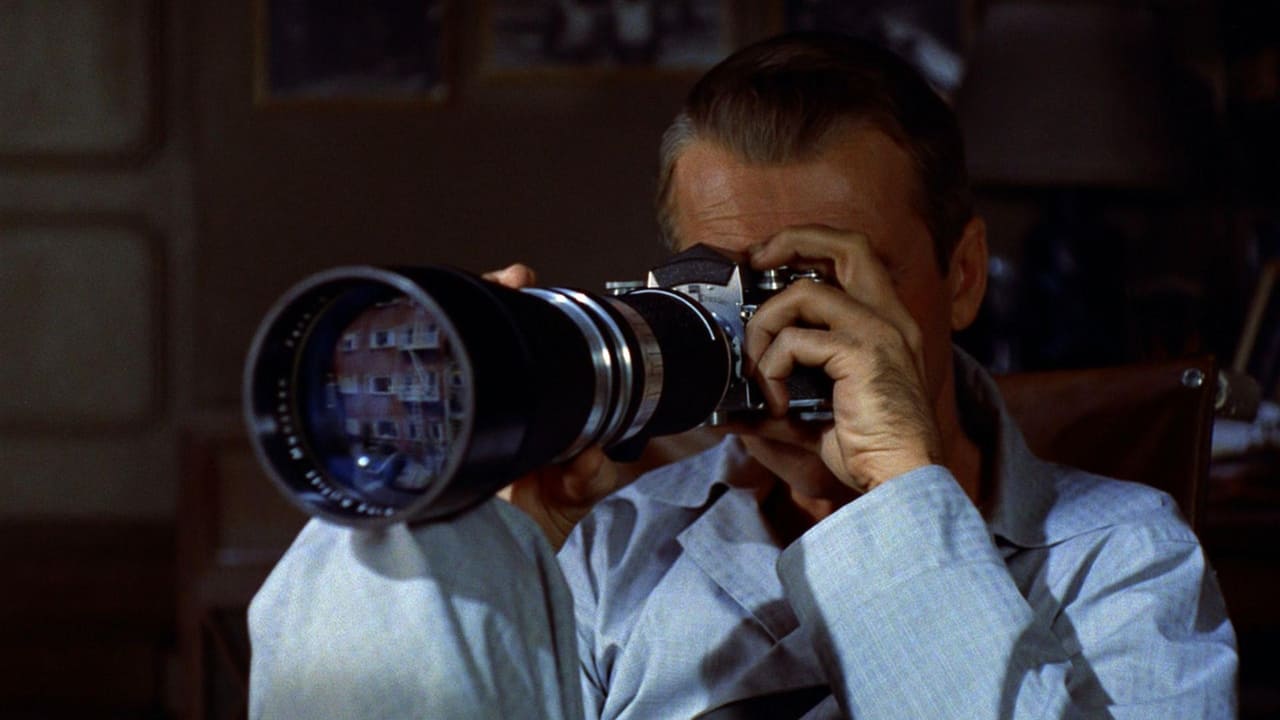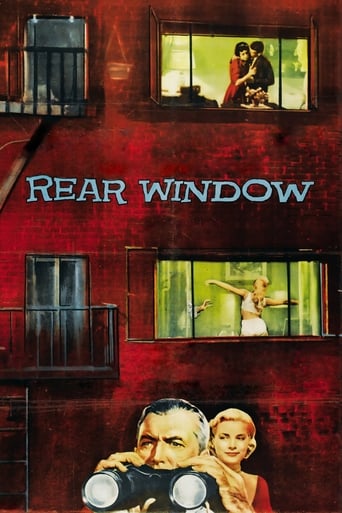

This movie is exteremlely intense and suspenseful. In my opinion this movie is a masterpiece and deserves its place in cinema history.
... View MoreWhen watching 'Rear Window,' it was very prominent from the beginning that Alfred Hitchcock was a very talented director. He did a very good job at captivating the viewer and making them feel as if they were in the apartment instead of Jeffries. The way the film was shot made it seem like you were right there looking across at the other apartments instead of watching Jeffries do it. It was impressive that Hitchcock was able to build such a complex storyline with the main character stuck in his apartment the whole time. A good portion of the beginning of the movie is spent setting up all the different characters so that the viewer has a complete understanding of what is happening in the film. He portrays the smaller storylines in the film just as successfully as he does for the main one. They don't have a massive impact on the film but they force the viewers to become very observant and focus on more than one aspect of the film. We see the ups and down of the musician, the daily routine of the dancer and the artist on the bottom level as well as the main storyline with the salesman. Hitchcock also did a very good job at incorporating many different genres into this film. This keeps it from being one sided and keeps the viewers entertained. There's the obvious mystery aspect of the film to start, which was the most prominent genre to viewers. The whole premise of the movie is Jeffries trying to solve the mystery of what is happening in the apartment across from him. Secondly, there is the thriller feel to the film. This is what keeps the viewers on their seats and guessing throughout the movie. We are finding out information at the same time Jeffries is, so the viewers are surprised by the same things he is. Thirdly, there is the romantic part of the film with Jeffries and Lisa. This is one of the genres that makes the movie so complex. Along with the various other storylines in the movie there is relationship between Lisa and Jeffries that we see develop throughout the movie. Lastly, there is a somewhat light comedic feel to the movie at some parts. The majority is not even somewhat related to comedy but there are few scenes that have a lighter and more relaxed feel that makes the movie even better-rounded. Lastly, Hitchcock did a very good job using mise-en-scene in this film. The detail that is in each scene of this movie is one of the main things that makes it so good. If you look in the background of each scene everything is perfect in comparison to the character that it is with. For example, in Jeffries' apartment if you look in the background it isn't just any normal apartment. You can see various items that correspond with his career as a photographer that make you view his apartment as a whole along with Jeffries, not as two separate parts of the film. Hitchcock also did a very good job with mise-en-scene when it came to the apartments across from Jeffries. Each separate apartment is like a completely different lifestyle. You see the people all around the salesman's apartment living their everyday lives as if nothing's wrong throughout the movie. He doesn't just dial in on that one apartment for the rest of the movie once we find out something isn't right, the apartment becomes the main focus, but not the only focus. We still throughout the movie see the other characters going about their business.
... View MoreRear Window From an artistic perspective, I thought that this movie was very well done. The colors were vibrant but also showed the dullness that living in an urban environment can have. I also enjoyed the costumes and makeup of all the actors. I found that it reflected the time period well and accurately represented what a middle class person would dress and look like. I also enjoyed the sounds that were incorporated into the film. Throughout the film, birds could be heard or dogs barking and this gave a very open feel to the otherwise closed in feeling of being in a walled in apartment complex. Another very good aspect of the film was the quality of the actors. Throughout the movie, the actors do a very good job of "show don't tell." What I mean by this is that many scenes in the movie do not need the actors telling each other how they feel and it can be read on their faces. An example of this is when Grace comes to the realization that LB's theory that Lars killed his wife may have some truth behind it. You can see the change of expression on her face and without her even saying anything, the audience knows what she is thinking. The film had a very slow and relaxing feel at the beginning which I found interesting because it would be the opposite of what you might feel living in a downtown apartment. At the beginning of the film, the camera pans from apartment to apartment showing the daily lives of the people around LB. This gives us the feeling that we are actually looking through LB's eyes and feeling what he feels. I had a slight sense of loneliness when watching this because I felt that all of this was going on around me but I still felt distant and not a part of it all. I believe this is what Hitchcock was intending when filming this because it allows us to relate more to LB. During this scene, and in many other parts of the movie, it is as if LB is actually in a movie theater watching all of this unfold in front of him. In many scenes, such as the one where Grace breaks into Lars' house, LB must sit back helpless and watch it all take place as with the audience in the theater or the viewers at home. I found this very unique in that I have never experienced this perspective with any other movie I had seen. One thing about the film that can be seen as both a positive and a negative is the fact that there is a very long buildup from the beginning of the film to the climax. Although this can be seen as very important aspect of the story, I found it kind of boring at times and a little slow. There were times that I found myself spacing out and losing focus in the film. While I believe that a large portion of the film was slow, the last half hour of the movie had me on the edge of my seat. When Grace broke into the apartment and when Lars confronted LB were very well done. I felt the suspense that LB felt because we both felt that we were helpless and trapped in our seats.
... View MoreI must admit, I was skeptical at first about Hitchcock's suspense thriller "Rear Window." It's just another older film with the same murder-mystery plot to it where the protagonist sees a murder, has a relationship with some woman from the police academy, then gets in a final showdown with the main antagonist. They arrest the antagonist, and everyone goes on their merry way.Boy was I caught off guard by how well this movie was made. Taking place in 1950s New York City, it had a very nostalgic feeling in the introduction. Using Hitchcock's signature opening style, we glimpse into the life of a recently handicapped photographer who looks out his window and observes his neighborhood. This was unlike any other movie I have ever seen, in that the movie only has about four or five viewpoints: Jeff's view, looking into Jeff's room, looking out Jeff's window from farther back in his room, and through the magnified lenses to name most of them.Contrary to my original belief that a film needs to be fluid with its location, "Rear Window" completely changed my opinion on the matter. The focus on the minor characters was also very impressive. Each minor character, although not interactive, these characters let us peer into the life and blood of the courtyard where Jeff lives. A scream and sob in the night, and the dog is dead. Why did this have to happen? I mean it added a whole new level of seriousness to the film, but why the cute innocent dog? This is actually a very good decision on their part but it probably hurt me more than it hurt the dog's owners. I hate it when animals die.Going off of that, most action occurs in the dark. This is immaculate use of mise-en-scène; it gives the scene a much more serious undertone. If the action took place during the day, then the scenes would not be as effective. Miss Lonelyhearts is a sad woman who lives in the bottom of Jeff's courtyard. She has been struggling romantically, as portrayed by the mise-en-scène of her apartment. The apartment gives off the vibe that it is full of things yet still missing something. This is truly apparent when she is sitting and eating dinner by herself and sobbing.Jeff's musical neighbor that lives in the studio apartment always has a party. The composer that lives there loves his piano, and actually plays a significant part in the plot by getting Miss Lonelyheart's attention.The only area that I feel that this film falls short is in some of the character development.Why does Lisa think it's a good idea to go into the murderer's apartment? I mean, sure she got the ring, but this was probably the one of the stupidest decisions I've ever seen made by a director in a live action film. Second only to the decision made by Rian Johnson, the director of Disney's "Star Wars: The Last Jedi," to have Princess Leia suddenly become force sensitive and use the force to re-enter the rebel ship. I guess Lisa had to do something like "make a daring attempt to retrieve the wedding ring of Mrs. Thorwald (and succeed) that may or may not even be in the murderer's apartment" to move the plot forward. The other question about the film has got to be, "why does the ballet dancer even exist in the script?" The only reason I can see for her being written into the script is to draw attention to the outside world. In the word's of Alfred Hitchcock himself, "I'll bet you that nine out of ten people, if they see a woman across the courtyard undressing for bed...will stay and look."All in all, this film is a great watch. I recommend it to all Hitchcock fans everywhere!
... View More